V-Go Insulin Delivery System: Uses, Dosages, Safety Information
Posted by Prescription Hope - See Editorial Guidelines (Last Updated On: Fri Apr 21 2023)
Those suffering from type 2 diabetes may be looking for a treatment plan that works better than the one that they are already on. Especially those that require insulin may need an easier way to receive their dosage. V-Go insulin delivery system may be an intervention that can provide some people relief. In this article, we’ll discuss what V-Go is, who it’s for, and how it works. Here’s a quick summary before discussing the specific details. What is V-Go Insulin Delivery System? V-Go is an insulin delivery system that comes in the form of a wearable patch. It is filled with short-acting insulin and provides a steady dose of insulin all day and night. The device is placed on either the patient’s stomach or the back of their arm. In short, V-Go is an insulin pump specifically for type 2 diabetes patients. Here is everything you should know about the V-Go insulin delivery system.
What is V-Go?
 The V-Go insulin delivery system is classified under medical supplies and devices. It is a small patch-like device applied to a patient’s stomach or back of the arm to provide a continuous delivery of insulin. It is prescribed to those with type 2 diabetes to help them gain better control over their blood sugar levels.
Those with type 2 diabetes may need insulin if other diabetes medications do not provide them with proper blood sugar control. Administering insulin with syringes or pens can be painful and frustrating. It can be inconvenient and awkward to administer insulin with syringes or pens in many situations throughout life.
This is where V-Go can be beneficial. There is no need for multiple daily injections with this device, and it easily and discretely provides you with the insulin you need.
The V-Go insulin delivery system is classified under medical supplies and devices. It is a small patch-like device applied to a patient’s stomach or back of the arm to provide a continuous delivery of insulin. It is prescribed to those with type 2 diabetes to help them gain better control over their blood sugar levels.
Those with type 2 diabetes may need insulin if other diabetes medications do not provide them with proper blood sugar control. Administering insulin with syringes or pens can be painful and frustrating. It can be inconvenient and awkward to administer insulin with syringes or pens in many situations throughout life.
This is where V-Go can be beneficial. There is no need for multiple daily injections with this device, and it easily and discretely provides you with the insulin you need.
Who is V-Go For?
V-Go is for those that have type 2 diabetes and require insulin therapy. This device may not be right for any individual that requires less than 20 units of basal insulin or more than 40 units of basal insulin in a 24-hour period. It may not be right for those that require a bolus in increments that are less than 2 units. V-Go is not indicated for those with type 1 diabetes.Does V-Go Come With Insulin?
The V-Go insulin delivery system does not come with insulin. You should receive a separate prescription for a short-acting insulin that comes in a vial of 10 ml. The amount of insulin you need to be prescribed will vary depending on your condition. The V-Go system comes in three different sizes based on the amount of insulin you need in a day. The dosing options for V-Go include:- V-Go 20 – Has a preset basal rate of 20 units per 24-hour period (.83 U/hr.) and holds up to 56 units of insulin.
- V-Go 30 – Has a preset basal rate of 30 units per 24-hour period (1.25 U/hr.) and holds up to 66 units.
- V-Go 40 – Has a preset basal rate of 40 units per 24-hour period (1.67 U/hr.) and holds up to 76 units.
How Does V-Go Work?
To fill the V-Go system with insulin, you slide the V-Go into the “EZ Fill,” followed by the vial of insulin but on the opposite side. There is a plunger on the “EZ Fill” that you first slide up, then slowly back down. The system is now filled and ready to be placed on the body. The system uses adhesive to attach to the patient’s stomach or back of the arm. Make sure to clean the application site of your body with an alcohol swab. There is a needle button on the system that you push down. When pushed, you will hear a click, and the needle will insert. This initiates the flow of insulin. The basal rate will automatically deliver once the needle is inserted. As mentioned earlier, the V-Go system comes with a preset basal rate. The basal rate is often referred to as background insulin and replaces the need for long-acting insulin. The basal rate is the amount of short-acting insulin that is automatically delivered per hour via the insulin pump. A bolus, or the insulin that is taken at meals, can be administered through just a click of a button. The button is located on the side of the V-Go device. Each click of the bolus button delivers two units of insulin. Follow your insulin to carb ratio to determine how many times you need to push the button to get your correct dose. V-Go last 24 hours. So, to take the device off, you just slide the needle release button. Then you simply remove the device and discard it.How Much Does V-Go Cost?
The cost of V-Go will vary based on an individual’s insurance coverage. However, V-Go is covered by Medicare Part D and most commercial insurance companies. A savings card may also be available to you, lowering the cost of V-Go to $75. A person’s out-of-pocket cost may be much more expensive. It is important to note that V-Go does not come with insulin. Therefore, a patient will have to pay for insulin in addition to the V-Go device. However, this system may still be more affordable than multiple daily injections.V-Go Safety Information and Side Effects
The V-Go device should NOT be worn in an MRI or during other test procedure. You should remove the device before an MRI, X-ray, and so on. You will need to place a new V-Go back on after the test procedure is over. You should still monitor your blood sugar carefully when using this device. It is recommended that you check your blood sugar at least three times a day. This will help you prevent low or high blood sugar levels. Emergency supplies should be kept handy in the case where V-Go stops insulin delivery. These emergency supplies may include backup insulin, a syringe, glucose tablets, and extra blood glucose monitoring supplies.
Avoid exposing your V-Go device to extreme temperatures. This includes going into a hot tub or sauna. You should remove the device prior to exposing yourself to extreme temperatures.
V-Go can go underwater, and it will continue to work. However, it is important that you check to make sure the device is secure after going underwater or if you have engaged in physical activity.
You should rotate the application site each time you change the device. Check for skin irritation, such as redness or swelling, after removing the adhesive. Do not apply the device to an area of the skin that is irritated or infected. Prepare and clean the infusion site properly to avoid infusion site infections.
With the use of insulin comes the risk of low blood sugar (hypoglycemia). Hypoglycemia can occur with the use of V-Go if the patient needs adjustments to their basal rate throughout the day or requires a bolus that is less than 2 units. Hypoglycemia can be life-threatening. You must treat low blood sugar levels immediately.
High blood sugar (hyperglycemia) can occur if the patient experiences a problem with their V-Go device. If insulin delivery is stopped or if there is a mechanical issue, then hyperglycemia can occur. Hyperglycemia can cause health complications if it is not treated.
Emergency supplies should be kept handy in the case where V-Go stops insulin delivery. These emergency supplies may include backup insulin, a syringe, glucose tablets, and extra blood glucose monitoring supplies.
Avoid exposing your V-Go device to extreme temperatures. This includes going into a hot tub or sauna. You should remove the device prior to exposing yourself to extreme temperatures.
V-Go can go underwater, and it will continue to work. However, it is important that you check to make sure the device is secure after going underwater or if you have engaged in physical activity.
You should rotate the application site each time you change the device. Check for skin irritation, such as redness or swelling, after removing the adhesive. Do not apply the device to an area of the skin that is irritated or infected. Prepare and clean the infusion site properly to avoid infusion site infections.
With the use of insulin comes the risk of low blood sugar (hypoglycemia). Hypoglycemia can occur with the use of V-Go if the patient needs adjustments to their basal rate throughout the day or requires a bolus that is less than 2 units. Hypoglycemia can be life-threatening. You must treat low blood sugar levels immediately.
High blood sugar (hyperglycemia) can occur if the patient experiences a problem with their V-Go device. If insulin delivery is stopped or if there is a mechanical issue, then hyperglycemia can occur. Hyperglycemia can cause health complications if it is not treated.
Conclusion
Managing any type of diabetes can be difficult. We hope this gave you a better understanding of the V-Go insulin delivery system and how it works. Those that have type 2 diabetes may benefit from this device and experience a lower A1c and better control over their blood sugar levels. If you are having trouble affording your insulin or other prescription drugs, then Prescription Hope may be able to help. Prescription Hope works with 180 pharmaceutical manufacturers to provide individuals with their prescribed medication at a set, affordable cost. Enroll with us and pay just $60.00 a month through Prescription Hope’s medication access service for each of your medications.ENROLL



